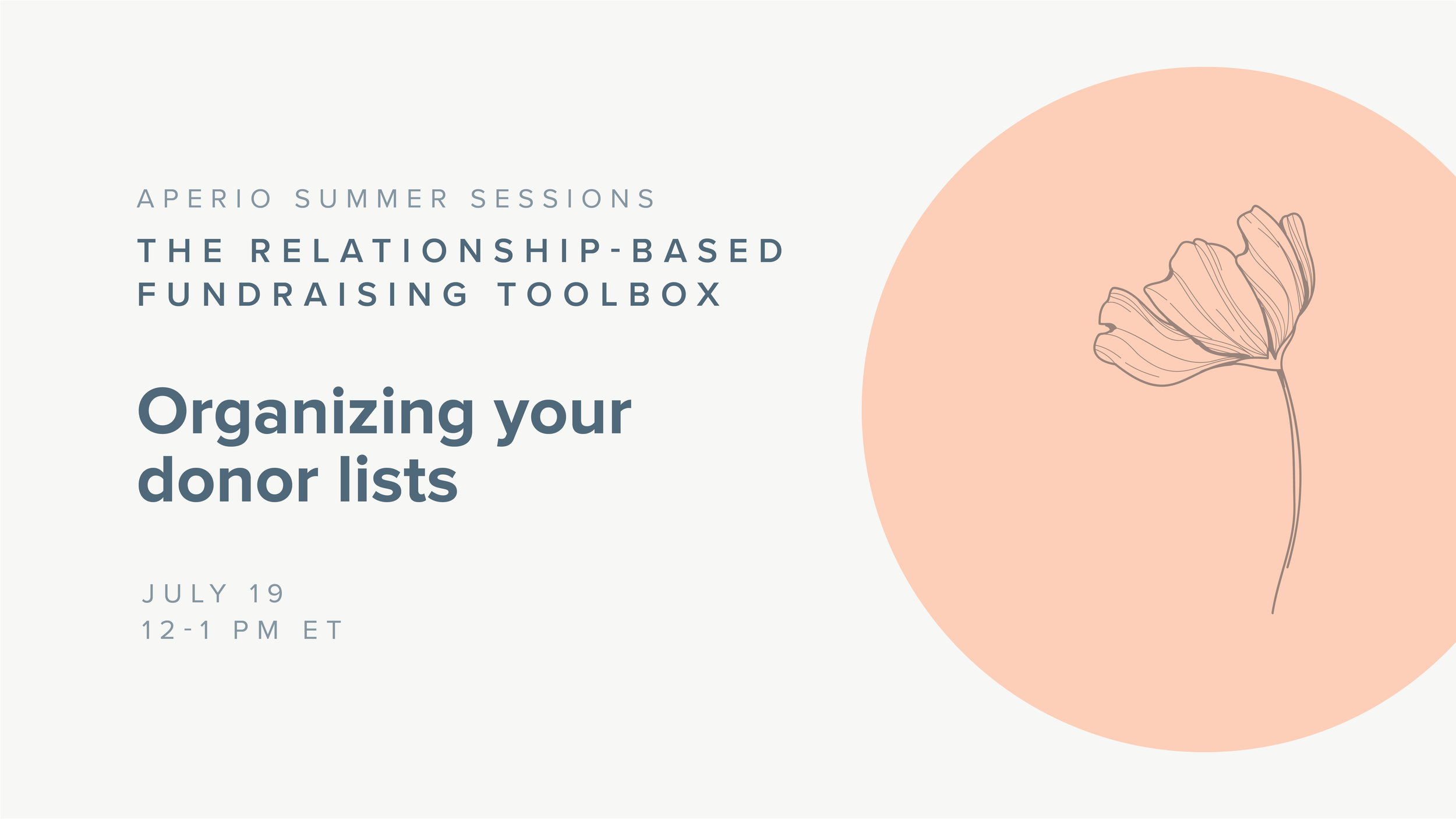Organizing your donor lists · Aperio summer sessions: The relationship-based fundraising toolbox
Summer is the season of organization for development teams. It’s when we step away from our busy day-to-day and prepare for the year ahead. We believe that your mission, your donors, and your team have more potential—and we’re here to make it simple for you to realize that potential.
In the first of our three-part Aperio summer sessions: The relationship-based fundraising toolbox series, led by Aperio Senior Directors Kelly Braunegg and Toni Koch, we dove into:
How to approach donor list segmentation
How to identify and prioritize high-potential donors
How to segment everyone else on your list
Watch the full event recording on YouTube.
Donor list segmentation
You may already have organized lists or a way that you approach your donors. So, why is it necessary to segment our lists?
Simply put: Your database has more potential.
On average, nonprofits retain about 45% of donors year-over-year—and that means 55% of donors do not renew. If your organization does not yet have a middle or major giving program, your retention rate is likely much lower.
Retention will never be 100%, Kelly says [watch the full event recording here], but every percentage point increase represents significant revenue—and a reduction in the cost to raise a dollar because retention is less expensive than acquisition. The ‘profit’ on a first gift is minimal (or even negative in some channels). The real value of a donor comes in their lifetime of giving.
As we shift to relationship-based fundraising overall, we will see: That additional potential for revenue growth has been there all along.
Donors don’t need fancy tech or big events, Kelly explains. They need authentic engagement from your team. Providing this experience at scale for a big list can feel daunting—and that’s where segmentation comes in.
Segmentation—organizing your lists—elevates the donor experience by making collaboration easier. It enables you to efficiently plan robust donor experiences, clarify roles and responsibilities, and operationalize your donor outreach.
Conduct a database inventory
How you segment your donors will depend on what your list looks like—so a careful analysis of your database is a good place to start. [If this feels overwhelming, we can help!]Select your donor segments
When we segment donors, there are lots of factors we can consider. Some examples are donation recency, frequency, type, and amount; and the donor’s giving potential, motivations, and interests.Choose your approach
There are many ways to approach segmentation. Watch the event recording for Kelly’s detailed breakdown and advice on how to choose the approach that best suits your organization’s needs and capacity.
Identifying & prioritizing high-potential donors
So, what makes someone a high-potential donor? Toni explains: The people or institutions we should be prioritizing should be those with high capacity, who have a demonstrated interest in your mission and who are giving beyond events.
We rely on a principle called capacity plus. Many organizations start by looking at past giving, and that can be among the factors considered—but the non-negotiable is their capacity for future giving.
Whether we see it in a wealth screening, giving to other organizations, net worth, or other indicators, Toni says, we have to have some reason to believe that the person or organization has the ability to make a large gift. [Need help wealth screening? Get in touch!]
The ‘plus’ is where other factors come in: What else makes you think this donor is a strong prospect? Watch the event recording to dig deeper into what kinds of factors make for a high-potential donor and how to generate that information using your current lists.
Once you’ve segmented your list and identified your high-potential donors, you can set expectations for how you will focus your energy—and how you expect your revenue to grow as a result.
While your top ‘tier’ of donors may only be 20 people, you should focus the bulk of your time and investment there, and expect to gain the bulk of your revenue there.
How will you make that happen? Toni explains that those high-potential donors will receive the most personalized experience. (All donors’ experiences should be excellent; the difference the level of personalization.) Watch the event recording for details on how to segment and tier the remaining contacts in your list, and how to assign responsibilities to your team to ensure no donor falls through the cracks.
What’s next?
From your organization’s perspective, an organized list combined with an engagement plan, which we’ll discuss at the next session ensures that:
No donor falls through the cracks
All donors are treated well, but not equally—meaning that you create special opportunities for donors as they grow in their impact on your mission
Everyone internally knows their role and plays it—so engagement is simple and seamless, and it’s not a confusing hassle to get each mailing out or each cultivation event planned


